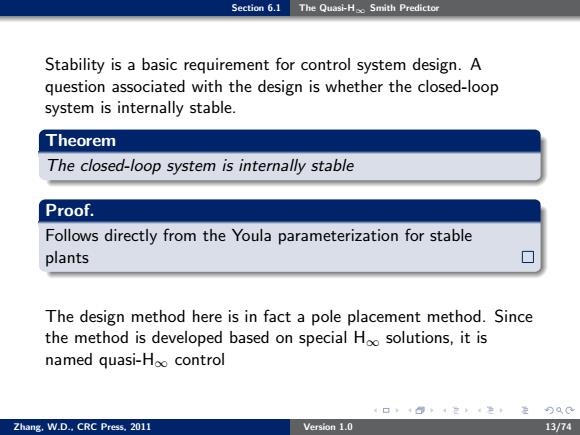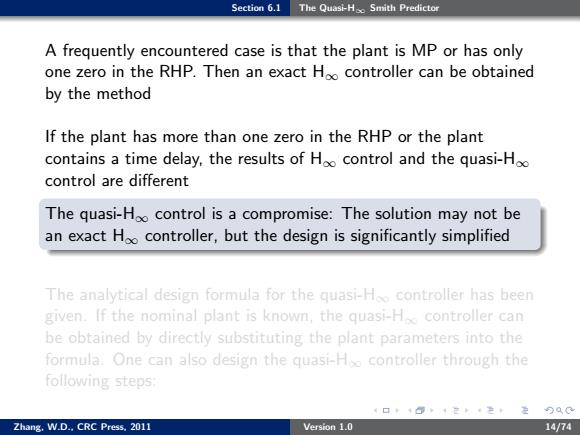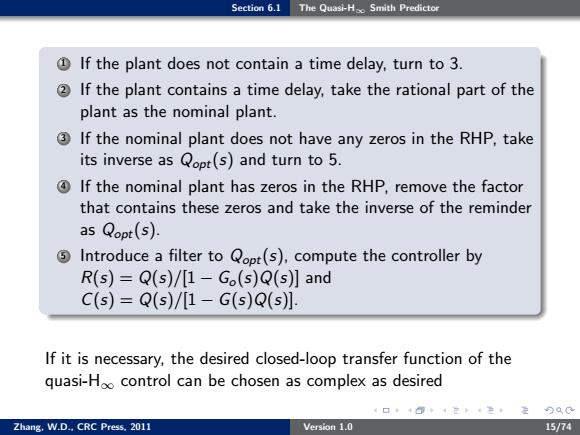
Section 6.1 The Quasi-Ho Smith Predictor Stability is a basic requirement for control system design.A question associated with the design is whether the closed-loop system is internally stable. Theorem The closed-loop system is internally stable Proof. Follows directly from the Youla parameterization for stable plants The design method here is in fact a pole placement method.Since the method is developed based on special Ho solutions,it is named quasi-Hoc control 4口,+@,4定4定90C Zhang.W.D..CRC Press.2011 Version 1.0 13/74
Section 6.1 The Quasi-H∞ Smith Predictor Stability is a basic requirement for control system design. A question associated with the design is whether the closed-loop system is internally stable. Theorem The closed-loop system is internally stable Proof. Follows directly from the Youla parameterization for stable plants The design method here is in fact a pole placement method. Since the method is developed based on special H∞ solutions, it is named quasi-H∞ control Zhang, W.D., CRC Press, 2011 Version 1.0 13/74

Section 6.1 The Quasi-Ho Smith Predictor Stability is a basic requirement for control system design.A question associated with the design is whether the closed-loop system is internally stable. Theorem The closed-loop system is internally stable Proof. Follows directly from the Youla parameterization for stable plants The design method here is in fact a pole placement method.Since the method is developed based on special Hoo solutions,it is named quasi-Hoo control 4口,+@,4定4定90C Zhang.W.D..CRC Press.2011 Version 1.0 13/74
Section 6.1 The Quasi-H∞ Smith Predictor Stability is a basic requirement for control system design. A question associated with the design is whether the closed-loop system is internally stable. Theorem The closed-loop system is internally stable Proof. Follows directly from the Youla parameterization for stable plants The design method here is in fact a pole placement method. Since the method is developed based on special H∞ solutions, it is named quasi-H∞ control Zhang, W.D., CRC Press, 2011 Version 1.0 13/74

Section 6.1 The Quasi-Ho Smith Predictor A frequently encountered case is that the plant is MP or has only one zero in the RHP.Then an exact Hoo controller can be obtained by the method If the plant has more than one zero in the RHP or the plant contains a time delay,the results of Hoo control and the quasi-Hoo control are different The quasi-Hoo control is a compromise:The solution may not be an exact Hoo controller,but the design is significantly simplified The analytical design formula for the quasi-Hoo controller has been given.If the nominal plant is known,the quasi-H controller can be obtained by directly substituting the plant parameters into the formula.One can also design the quasi-Hoo controller through the following steps 4口,+@,4定怎 定9QC Zhang.W.D..CRC Press.2011 Version 1.0 14/74
Section 6.1 The Quasi-H∞ Smith Predictor A frequently encountered case is that the plant is MP or has only one zero in the RHP. Then an exact H∞ controller can be obtained by the method If the plant has more than one zero in the RHP or the plant contains a time delay, the results of H∞ control and the quasi-H∞ control are different The quasi-H∞ control is a compromise: The solution may not be an exact H∞ controller, but the design is significantly simplified The analytical design formula for the quasi-H∞ controller has been given. If the nominal plant is known, the quasi-H∞ controller can be obtained by directly substituting the plant parameters into the formula. One can also design the quasi-H∞ controller through the following steps: Zhang, W.D., CRC Press, 2011 Version 1.0 14/74

Section 6.1 The Quasi-Ho Smith Predictor A frequently encountered case is that the plant is MP or has only one zero in the RHP.Then an exact Hoo controller can be obtained by the method If the plant has more than one zero in the RHP or the plant contains a time delay,the results of Hoo control and the quasi-Hoo control are different The quasi-Hoo control is a compromise:The solution may not be an exact Hoo controller,but the design is significantly simplified The analytical design formula for the quasi-Hoo controller has been given.If the nominal plant is known,the quasi-Hoo controller can be obtained by directly substituting the plant parameters into the formula.One can also design the quasi-Hoo controller through the following steps: 240 Zhang.W.D..CRC Press.2011 Version 1.0 14/74
Section 6.1 The Quasi-H∞ Smith Predictor A frequently encountered case is that the plant is MP or has only one zero in the RHP. Then an exact H∞ controller can be obtained by the method If the plant has more than one zero in the RHP or the plant contains a time delay, the results of H∞ control and the quasi-H∞ control are different The quasi-H∞ control is a compromise: The solution may not be an exact H∞ controller, but the design is significantly simplified The analytical design formula for the quasi-H∞ controller has been given. If the nominal plant is known, the quasi-H∞ controller can be obtained by directly substituting the plant parameters into the formula. One can also design the quasi-H∞ controller through the following steps: Zhang, W.D., CRC Press, 2011 Version 1.0 14/74

Section 6.1 The Quasi-Ho Smith Predictor If the plant does not contain a time delay,turn to 3. 2 If the plant contains a time delay,take the rational part of the plant as the nominal plant. 3 If the nominal plant does not have any zeros in the RHP,take its inverse as Qopt(s)and turn to 5. If the nominal plant has zeros in the RHP,remove the factor that contains these zeros and take the inverse of the reminder as Qopt(s). Introduce a filter to Qopt(s).compute the controller by R(s)=Q(s)/[1-Go(s)Q(s)]and C(s)=Q(s)/1-G(s)Q(s1 If it is necessary,the desired closed-loop transfer function of the quasi-Hoo control can be chosen as complex as desired 290 Zhang.W.D..CRC Press.2011 Version 1.0 15/74
Section 6.1 The Quasi-H∞ Smith Predictor 1 If the plant does not contain a time delay, turn to 3. 2 If the plant contains a time delay, take the rational part of the plant as the nominal plant. 3 If the nominal plant does not have any zeros in the RHP, take its inverse as Qopt(s) and turn to 5. 4 If the nominal plant has zeros in the RHP, remove the factor that contains these zeros and take the inverse of the reminder as Qopt(s). 5 Introduce a filter to Qopt(s), compute the controller by R(s) = Q(s)/[1 − Go(s)Q(s)] and C(s) = Q(s)/[1 − G(s)Q(s)]. If it is necessary, the desired closed-loop transfer function of the quasi-H∞ control can be chosen as complex as desired Zhang, W.D., CRC Press, 2011 Version 1.0 15/74